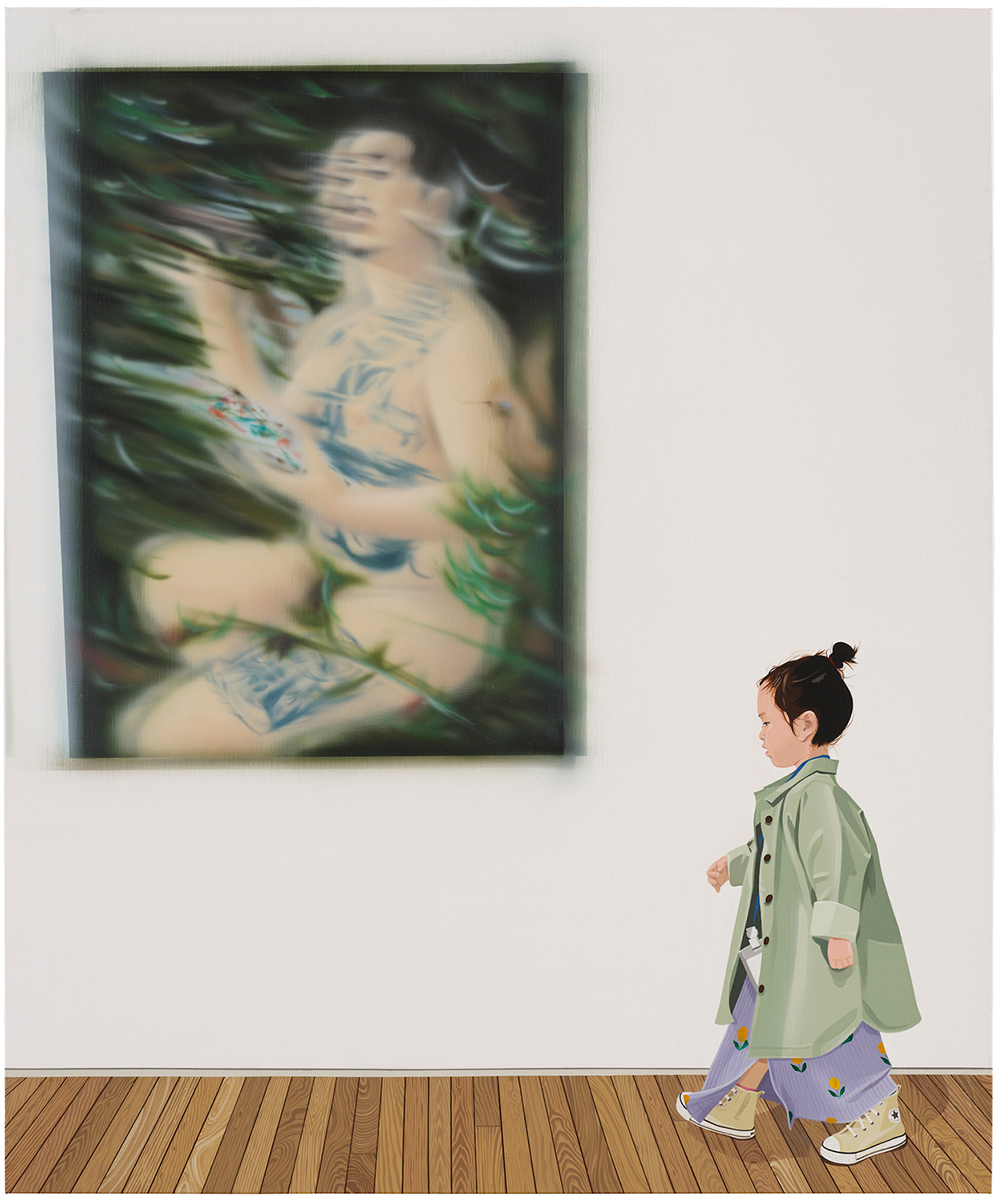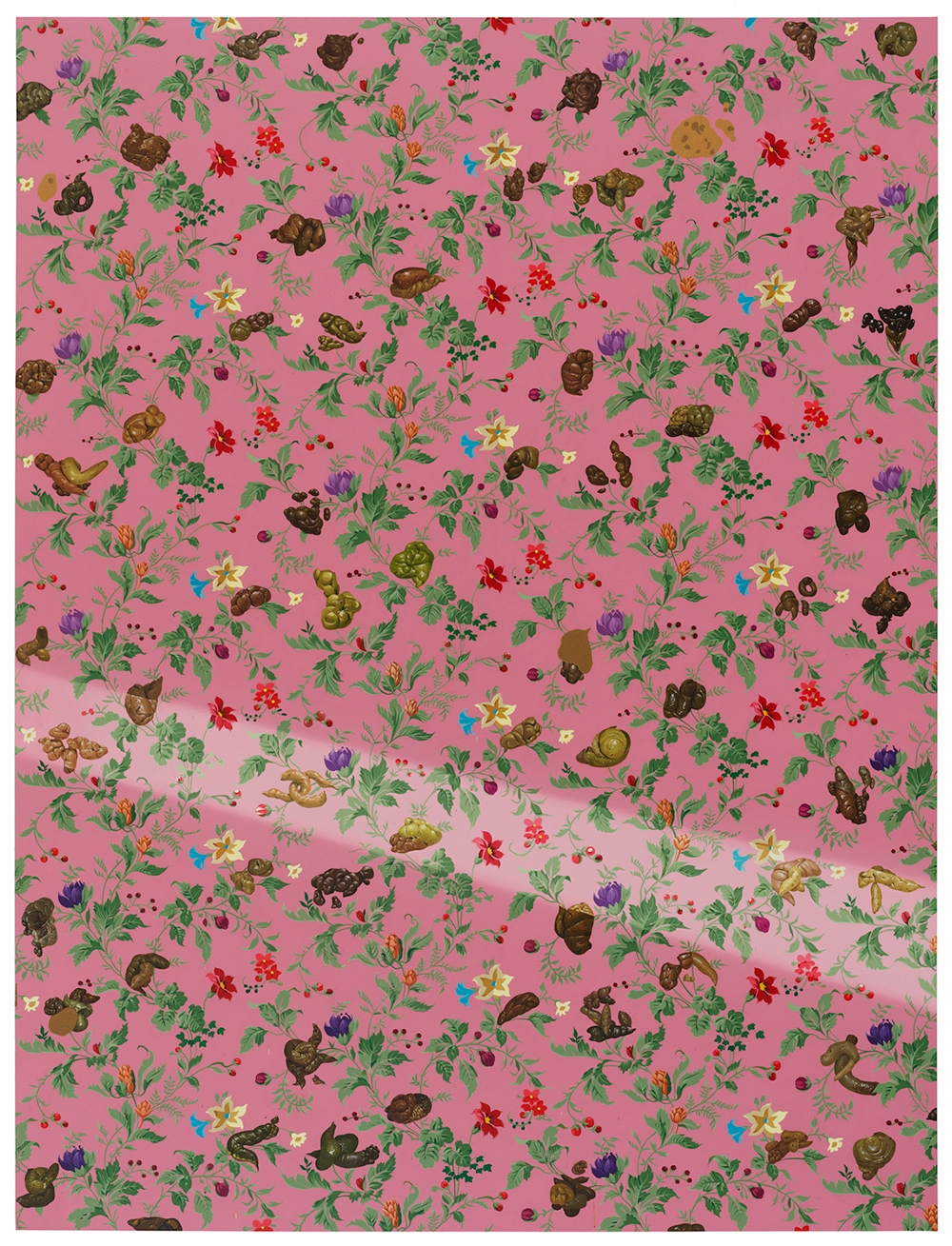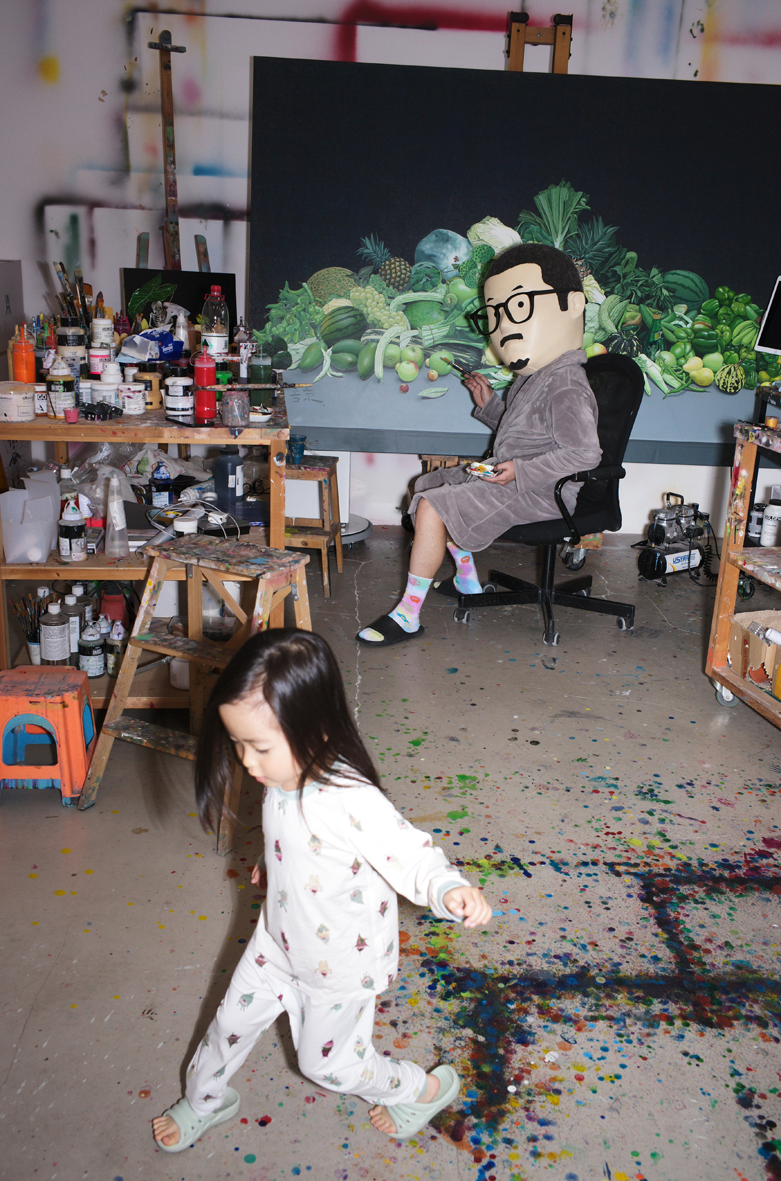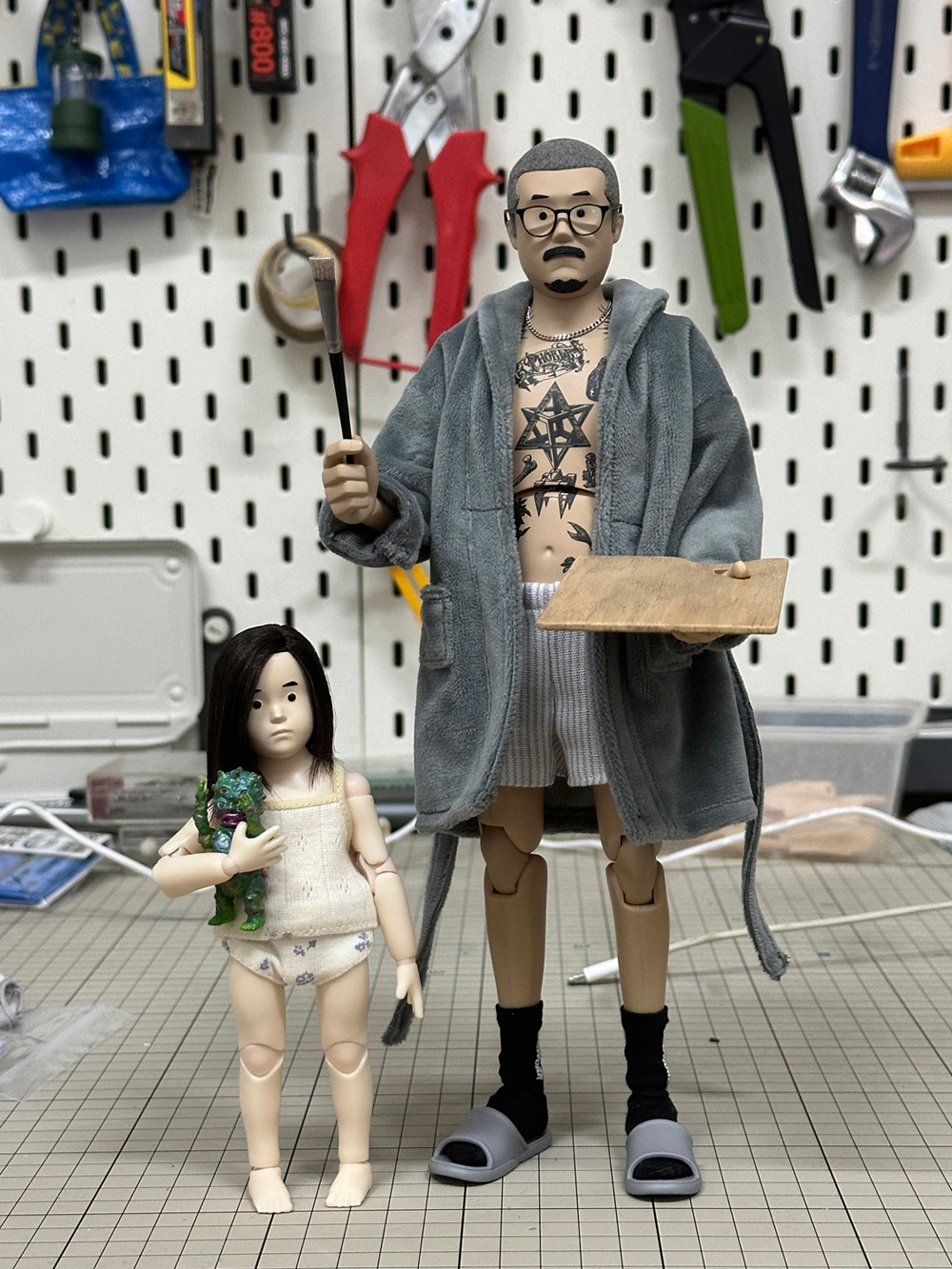EXHIBITION
CHEN Fei (陳飛) was born in 1983 in Shanxi, China, and now resides in Beijing. The exhibition showcases 15 works by Chen Fei created between 2022 and 2025, a towering seven-meter mural, installations and documents, presented within a unique, site-specific curatorial design.
Drawing on the iconic German comic Vater und Sohn (Father and Son) as its starting point, the exhibition references a timeless publication created by renowned German cartoonist E. O. Plauen (1903-1944), who was profoundly affected during the Nazi era. This work not only depicts the relationship between father and son but also explores the valuable and thought-provoking meanings of family, companionship, and love in its unique historical context in a very specific social setting.
Resonating with E. O. Plauen's story, Chen Fei employs an autobiographical approach in this exhibition to illustrate relationships with individuals he knows intimately, interweaving narratives about his identity as a Chinese painter. The works delve into familial relationships between husband and wife, father and child, as well as social dynamics among colleagues and friends. The project also encompasses the painter’s contemplation of his own professional image as an artist.
Writing about painting has never come easily to me. I have always felt that painting constitutes its own system of language—one that constructs a kind of visual theatre on a flat surface through medium, gesture, colour, composition, atmosphere, and thought. The way into it varies from person to person. My motivations for making work are often tied to my shifting states of being: sometimes they emerge diffusely, in fragments; other times, they arrive through deliberate and careful orchestration. This fluctuation makes any attempt to trace a linear logic through my practice all the more difficult. In general, this body of work came about less through planning than through an intuitive process.
It began during the pandemic and continues into the present. I have often felt that we now live in a world that is, at times, subtly hostile—and perhaps that sense of estrangement has led to what one might call a kind of regression in my painting. Amid the growing sense of disarray, the feeling of having any real agency begins to slip away. As someone who once claimed a realist stance, hoping to engage with the times through representation, I found myself pulled into a state of paralyzing helplessness. Under these circumstances, even the act of addressing reality felt hollow and insufficient.
Then something unexpected happened: I became a father. Life’s center shifted, and my energy was naturally redirected toward the child’s growth. This shift released me, to some extent, from the anxieties I had harboured about the world at large, and brought me back to a renewed understanding of life and a quiet trust in its unfolding. The experience reminded me of a comic I read in my youth—Father and Son by German cartoonist E. O. Plauen. The stories are simple, wordless vignettes about the everyday joy and tenderness between a father and his child. Stripped of any historical context, the drawings speak only of the raw, unfiltered bond that emerges through kinship.
Though Plauen’s time could not be more different from my own, his work stirred a faint recognition. A pervasive anxiety seems to hum beneath our daily lives. What futures are we walking toward by the choices we make today? And what versions of ourselves will those futures call forth? As a small voice within the overwhelming chorus, I can only drift in this unfathomable tide. Painting once offered me a form of shelter. I believed art was boundless—that it opened up a universe where the world was born of vast, intricate, and ungovernable forces of imagination. But that belief has started to shift. The rules of the real world increasingly encroach upon that threshold space. Painting feels closer than ever to the world outside it. The imaginative construction of space and time has become fatigued, burdened by its own concealment, while the absurdity of reality grows, like a hyperreal wormhole.
This series is, in a sense, an act of rescue. It pulls me back from the boundless sweep of what lies beyond and returns me to life itself—to something smaller, closer to the root of being. Through it, I rediscovered a language of expression. I once tried to give this body of work a more respectable title, something that would lend it a certain weight. But in the end, I realised it came down to something quite plain: I simply wanted to paint my child. I wanted to capture the feelings I have for her, to record our conversations, to mark this shared moment. Perhaps it is because, in all that she is, I glimpse something that feels unmistakably true.
Chen Fei
Chen Fei has been a friend of mine for over ten years. We come from different countries, belong to different generations, and our artistic practices are entirely distinct. Yet we’re connected by the same instinct—to engage with the world through painting. In that sense, we’re the same kind of painter. Even though we don’t speak the same language, I always feel a deep joy whenever we meet. How does he see the world now that he is a father? I am really looking forward to seeing his new solo exhibition in Tokyo!
―Izumi Kato (artist)
WORKS
-

PDF 2025 Acrylic on linen 120x100cm
-

Cartoonist’s voyage 2024 Acrylic on linen 290x220cm
-

Love sonnets 2024 Acrylic on linen 290x220cm
-

Supernatural 2022 Acrylic on linen, gold foil 120x100cm
-

From the documents of “Father and Child”
-
I’d like to begin with Love Sonnets.
This painting begins with a memory. My daughter was born prematurely, weighing just under two pounds. Frail from the start, she required constant care. And one of my unexpected daily duties as a new father was tracking her bowel movements.
Years passed, and as she grew stronger, I left that chapter behind. It wasn't until I was scrolling through my phone for something else that I stumbled across that forgotten archive—hundreds of diaper photos, each showing a different form and color.
They seemed almost like a language. Before my daughter could speak, perhaps she was already saying: “Daddy, I’m fine today. Look how perfect the shape is,” or “Daddy, I’m not feeling so well... the color’s a little off.” I didn’t recoil. Instead, I felt a quiet tenderness. Looking at them all together, it felt less like documentation and more like a long poem.
I’m well aware this is a father’s gaze—what touches me may not move anyone else. But I still felt an irresistible need to give it form. As a painter, I couldn’t bring myself to render such residue literally. So I turned instead to the language of Neoclassicism, and to the way William Morris arranged forms across surface—reconfiguring the images like wallpaper, flattened and ornamented. That felt like the most fitting approach. A single beam of light cuts through the surface, breathing air into a composition saturated with form. This is, undeniably, a deeply personal painting. But then again, isn’t that why I became a painter in the first place—to please myself, before anyone else?
―Chen Fei (Expert from his concept text about the work)
PROFILE
-

From the documents of “Father and Child”
- CHEN Fei
Born in 1983 in Shanxi, CHEN Fei is a graduate of the Beijing Film Academy and now resides in Beijing. As an observant artist, Chen Fei excels at uncovering, capturing, and rearranging the fragments of time that linger in daily life after the disintegration of grand political narratives. Chen’s work embodies a dialectical inheritance of realist painting, one that has actively engaged with the course of China’s modernization. He turns his focus to the human condition within the empirical flow of time. His narrative portraits and contextual still lifes capture fleeting moments of everyday life, where the interplay between historical illusions and concrete reality emerges. At the same time, Chen’s temporal dramaturgy continuously rewrites lifestyles and settings. His self-portraits, where his identity shifts and transforms, reflect these seemingly parallel narratives, redistributing the weight of destiny across different dimensions. By forging unconventional connections between events, he reveals a collective temporal experience that defines our present.
He has held solo exhibitions at the Yuz Museum of Art Shanghai, Nizayama Forest Art Museum Japan, Today Art Museum Beijing, Gallery Perrotin New York, Paris, Hong Kong, and Galerie Urs Meile Beijing, Lucerne. In 2012, he won the Martell " Focus on Future Artistic Talent Award " and the Chinese New Painting Award in 2007.

